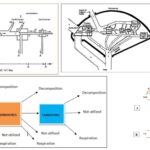Investigate simple diffusion and osmosis using plant tissue and non-living materials, including dialysis (Visking) tubing and agar
Investigate simple diffusion and osmosis using plant tissue and non-living materials, including dialysis (Visking) tubing and agar
Please login to submit an answer.
Exploring diffusion and osmosis through plant tissue and non-living materials provides a hands-on approach to understanding these processes. Here’s how each can be investigated:
1. Diffusion and Osmosis in Plant Tissue (e.g., Potato)
Aim: To observe osmosis in plant cells and how water movement across a semi-permeable membrane affects cell mass and texture.
Materials:
- Potato or other tuberous vegetable
- Solutions of different concentrations (e.g., distilled water, salt/sucrose solutions)
- Beakers or containers
- Balance (for mass measurements)
- Knife and ruler (for cutting consistent pieces)
Method:
- Cut potato slices to equal size and weigh each one.
- Place each slice in a different solution (pure water, and a series of increasing concentrations of salt or sugar solution).
- Leave the slices for a set period (e.g., 1–2 hours).
- Remove, dry gently, and weigh again to observe any changes in mass.
Observations:
- In pure water, potato slices may gain mass as water moves into cells by osmosis.
- In high salt/sugar solutions, slices might lose mass as water exits cells.
Explanation:
- Osmosis in plant tissue involves the movement of water through cell membranes, balancing the concentration gradients.
- A hypotonic solution (e.g., distilled water) will cause cells to swell, while a hypertonic solution (e.g., concentrated salt solution) will cause them to shrink due to water loss.
2. Diffusion Using Dialysis (Visking) Tubing
Aim: To mimic cell membrane selectivity and observe how small molecules can move through a semi-permeable membrane.
Materials:
- Dialysis (Visking) tubing
- Starch solution
- Iodine solution
- Glucose solution and glucose test strips
- Beaker or container
Method:
- Tie off one end of the Visking tubing and fill it with starch solution.
- Place the tubing in a beaker of iodine solution and observe if any color change occurs.
- In another experiment, place glucose solution inside the tubing and submerge it in water; test the water outside the tubing for glucose periodically using glucose test strips.
Observations:
- Starch does not pass through the tubing, while iodine can enter, producing a blue-black color if it reacts with starch.
- Glucose diffuses out of the tubing and can be detected outside the tubing in the water.
Explanation:
- Dialysis tubing acts like a semi-permeable membrane, allowing smaller molecules (iodine, glucose) to diffuse through, while larger molecules (starch) remain inside.
3. Diffusion Using Agar Gel
Aim: To visualize diffusion using dye in an agar gel medium.
Materials:
- Agar gel (prepared in a Petri dish)
- Dye or colored solutions (e.g., potassium permanganate)
- Ruler or timer
Method:
- Prepare agar gel in a Petri dish and allow it to set.
- Place a small drop of dye in the center.
- Measure the diameter of the dye spread at regular intervals to observe diffusion.
Observations:
- The dye diffuses out from the center, spreading through the agar gel.
Explanation:
- Agar acts as a medium where molecules move from areas of high to low concentration (simple diffusion). The rate can vary with temperature or concentration gradients.
Summary of Key Points
- Osmosis in plant tissue demonstrates how water moves across a cell membrane based on solute concentrations.
- Dialysis tubing models a semi-permeable membrane, illustrating selective permeability.
- Agar diffusion shows molecule movement through a gel medium, visualizing diffusion rates and patterns.
These experiments offer foundational insight into molecular movement principles that apply to living cells.
- Share on Facebook
- Share on Twitter
- Share on LinkedIn
Helpful: 0%




